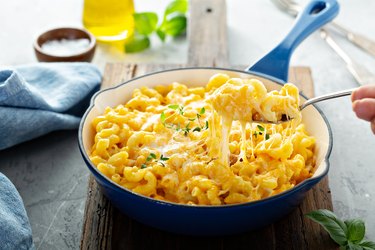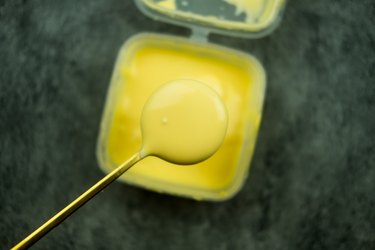
The only thing standing between you and gooey, cheesy joy is the five minutes it takes to whip up a pot of delicious cheese sauce. Unfortunately, this simple dish can easily go wrong. If you notice that your sauce seems to be separating or developing a chunky appearance, act quickly to save it. Curdled cheese sauce can often be saved by adding one of a few simple kitchen basics and putting your whisk to work.
Causes of Curdled Cheese Sauce
Video of the Day
There are a few things that can go wrong when making cheese sauce, causing it to curdle.
Video of the Day
- High heat may be the culprit, especially in a sauce that has a dairy base (as cheese sauce usually does, unless you're using something like almond milk as the base). High heat causes the protein and water in the dairy to separate, with the protein forming curds.
- The cheese itself may be causing the sauce to curdle, assuming it's also made from dairy (vegan "cheese" doesn't do this). The proteins and water in the cheese will separate if exposed to high temperatures.
- The oil in cheese may also separate when it's melted, causing the sauce to appear broken instead of smooth.
- Adding acid to a dairy-based sauce can also cause curdling.
Fixing Curdled Cheese Sauce
The first thing to do when you notice your cheese sauce is curdling is to immediately take it off the heat, as cooling the sauce may minimize the damage. Add a splash of the sauce's base liquid — if it's a milk-based sauce, for example, pour in a few teaspoons of cold milk. You may also add a splash of wine, beer, or cream. Whisk the sauce vigorously for about 10 seconds; this may be enough to repair a cheese sauce that's just beginning to curdle.
If that doesn't work, keep the sauce off the heat and grab some flour. Adding a small spoonful of flour thickens and bonds the separated sauce. After adding the flour, whisk it to minimize clumps and incorporate it into the sauce.
A little lemon juice, while acidic, may also help you bring a curdled sauce back together. Pour in just a splash (maybe 1/2 teaspoon) and immediately start whisking the sauce as vigorously as possible.
If none of those strategies improve the texture of your curdled cheese sauce, the last thing to try is running the sauce through a fine sieve or strainer. Place the strainer over a clean bowl, pour in the sauce, and use a rubber spatula to force the sauce through the tiny holes. This should smoothen out the sauce, though you'll likely lose some in the process of straining.
Tips for Smooth Cheese Sauce

Using starch is essential for creating a smooth, stable sauce. Starting with a béchamel base of flour and butter cooked together and thickened with milk generally yields a smooth sauce. Some cheese sauce recipes skip the flour and butter roux and instead use evaporated milk with cornstarch as a thickener. A mixture of just milk and cheese won't emulsify into a smooth sauce without the addition of some starch.
Remember that high heat is the enemy of smooth cheese sauce. In addition to cooking the sauce over low or medium heat, be careful not to add the cheese too soon. Finish cooking the sauce base, take it off the heat, and stir in the cheese. Finely grate the cheese first so the residual heat of the sauce is enough to melt it evenly without having to return the pan to the burner.